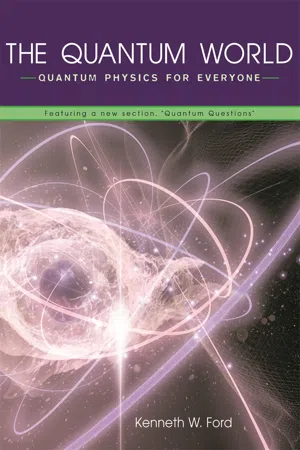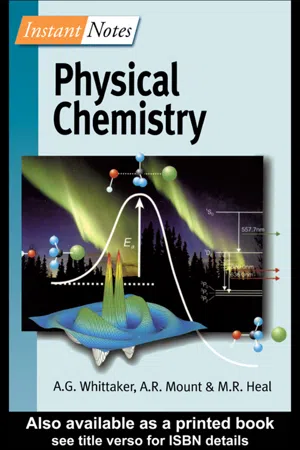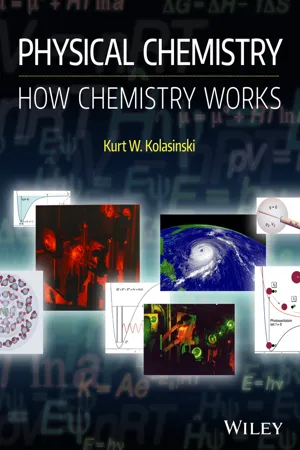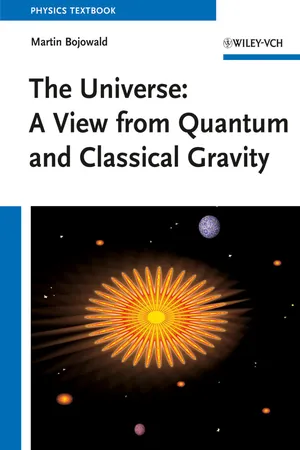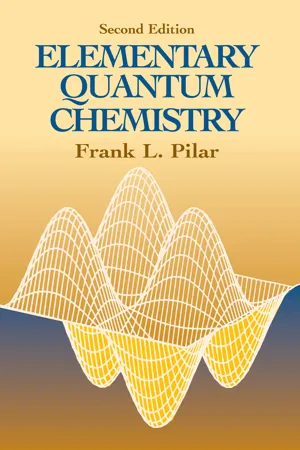Physics
Hydrogen Wave Function
The hydrogen wave function describes the probability amplitude of finding a hydrogen atom's electron at a particular location in space. It is a solution to the Schrödinger equation for the hydrogen atom and provides information about the electron's energy levels and spatial distribution. The wave function is used to calculate various properties of the atom, such as its orbital shapes and sizes.
Written by Perlego with AI-assistance
Related key terms
Related key terms
1 of 4
Related key terms
1 of 3
11 Key excerpts on "Hydrogen Wave Function"
- eBook - ePub
- Kenneth W. Ford, Paul Hewitt(Authors)
- 2011(Publication Date)
- Harvard University Press(Publisher)
The wave function of an electron in a particular state of motion in a hydrogen atom has a perfectly well-defined value at every point. Its square, the probability, is also perfectly definite. And this definiteness extends from one atom to another. If a thousand hydrogen atoms are all in the same state of motion, they all have identical wave functions and identical distributions of probability. What is not definite is advance knowledge of where the electron might be found as a particle if an experiment is conducted to pinpoint its location. Identical experiments carried out on the thousand atoms might reveal the electron’s location at a thousand different points. It’s a bit like throwing a pair of dice. You know exactly (if it’s a fair and balanced pair) the probability of throwing any given sum (1 ⁄ 6 for a sum of seven, 1 ⁄ 36 for “snake eyes,” and so on), but you never know in advance the result of any given throw. In late 1925, little more than a year after de Broglie postulated the wave nature of matter, Erwin Schrödinger, a multitalented Austrian physicist, came up with an equation that still bears his name. It is an equation that permits the calculation of the wave function—either precisely, as for a hydrogen atom, or in principle, for any system. * Schrödinger, thirtyeight at the time, was “elderly” compared with most of the other architects of the new quantum mechanics. † What Schrödinger’s equation does is generalize the de Broglie idea of a link between momentum and wavelength to situations where a particle’s momentum and therefore its wavelength vary continuously from one place to another. It might seem at first that a wave cannot have one wavelength at one place and a different wavelength at a slightly different place. Wavelength, by its very nature, seems to be something that is spread out. The wavelength of a water wave or of a vibrating string or column of air is the distance from one crest to the next - eBook - ePub
The Quantum World
Quantum Physics for Everyone
- Kenneth W. Ford(Author)
- 2005(Publication Date)
- Harvard University Press(Publisher)
choice among results of an event, and so on.As I mentioned in Chapter 6 , Einstein was unhappy about the appearance of probability in fundamental physics, and often said he could not believe that God played dice. Nearly all physicists have made peace with probability, but some remain uneasy about it. I very much doubt that the last word on quantum physics has been spoken.Waves and Granularity
Far from the center of an atom, the wave function of one of the atom’s electrons is very close to zero. The wave function may rise to a single maximum at the atom’s center, then fall again to near zero on the other side of the atom. Such is the wave function’s behavior for the lowest-energy state (the ground state) of the hydrogen atom, depicted in Figure 38 . For more energetic states (excited states), the wave function undergoes two or more cycles of oscillation: either in and out, toward and away from the atom’s center, as shown in Figure 39 , or round about, circumferentially around the nucleus.Figure 39. Electron wave function in higher-energy state of a hydrogen atom.This behavior is reminiscent of the vibration of a violin string in its fundamental mode and in its higher harmonics. The lowest vibration frequency of a string held fixed at its two ends has one-half wavelength over the length of the string. The second harmonic is one in which there is a full wavelength over the length of the string. The third harmonic has one-and-a-half wavelengths from end to end. And so on. It is in the nature of the rules governing sound that the frequency of the second harmonic is twice the frequency of the fundamental (up one octave, in musical terminology), the frequency of the third harmonic is three times the frequency of the fundamental, and so on. When a violin string is bowed, all of these overtones, as they are called, sound together. The particular quality of the sound depends on the relative intensities of the overtones. But what is important for this discussion is that the frequencies of vibration of the violin string are quantized. A string of given length and tension vibrates only at a discrete set of frequencies. - eBook - ePub
- Gavin Whittaker, Andy Mount, Matthew Heal(Authors)
- 2000(Publication Date)
- Taylor & Francis(Publisher)
2 at that point; a greater amplitude in the wavefunction corresponds to a greater probability density in the particle’s distribution.Schrödinger equation
The Schrödinger equation is the fundamental equation of quantum mechanics and has the general form:Each allowed wavefunctionψ1 ,ψ2 , ψ3…of a system described by a Hamiltonian operator , H , is associated with one particular allowed energy levelE1, E2 , E3 …(An operator is a mathematical function that represents the action of a physical observable.) The Hamiltonian operator is the operator for the total kinetic and potential energy of the system. Only an allowed wavefunction of the system, ψ , when operated on by H , returns the same wavefunction, multiplied by the associated constant value E . In mathematical terminology the Schrödinger equation is an eigenvalue equation; the pairs of E and ψ that satisfy the equation are the eigenvalues and eigenfunctions of H , respectively.A Schrödinger equation can be written to describe any particular physical system. For a particle of mass m moving in one dimension only (along the x- axis) the equation is:where-ħ2 /2m d2 /dx2and V (x ) are the operators for (one-dimensional) kinetic and potential energy, respectively, that together constitute the Hamiltonian operator. The symbol ħ is short-hand notation for h /2n (h is Planck’s constant - eBook - ePub
- Kenneth W Ford(Author)
- 2016(Publication Date)
- WSPC(Publisher)
–8 cm of the proton, within the region where the electron wave is large. The relative probability to reveal the electron at any place is proportional to the square of the wave function at that place for the state of motion of the electron that existed before the annihilation event.FIGURE 23.5 Probability in the hydrogen atom. (a) A high-energy positron can annihilate with the electron in the atom to produce a pair of gamma rays which can, in principle, locate the part of the atom where the annihilation event occurred. (b) The square of the wave function gives the probability per unit volume that the electron will manifest itself as a particle in such a process.Surprisingly at first thought, the wave nature of matter is also intimately connected with the granularity of the submicroscopic world. The very fact that an electron is not localized accounts for some of its quantized properties. The connection between waves and discreteness is pursued in Section 24.7 . Suffice it to note here that such a connection is in fact familiar in the macroscopic world. Piano strings have discrete fundamental frequencies because of their characteristic wave vibrations.23.6The uncertainty principle134One of the most important insights into nature revealed by quantum mechanics is the Heisenberg uncertainty principle. This is a general principle that takes many forms, but it will be sufficient to consider one of its forms, which can be writtenOn the right side is ħ, the ubiquitous Planck constant (here divided by 2π) which turns up in every equation of quantum mechanics. Momentum is represented by p, and position (distance) by x. The Δ symbols are used here to mean “uncertainty of” (not “change of”): Δx is the uncertainty of position, Δp is the uncertainty of momentum. The product of these two uncertainties is equal to the constant ħ. Since ħ is, on the human scale, a very small quantity, Δx and Δp can be so close to zero in the macroscopic world that there is for all practical purposes no uncertainty whatever in the position and momentum of large objects. If we wish to specify a man’s position to within the size of a single atom, his speed could, in principle, be determined to an accuracy of about 10–24 cm/sec. Needless to say, the inaccuracies of measurement take over long before the inherent fundamental limitation of accuracy implied by the uncertainty relation can play any role. But in the world of particles, this is not so. Masses and distances are so small that the uncertainty principle is of vital importance. An electron, in order to be localized within a distance 10–8 cm (which is equivalent to assigning it this great an uncertainty of position), has an inherent uncertainty of speed of about 108 - eBook - ePub
- Robert Weinstock(Author)
- 2012(Publication Date)
- Dover Publications(Publisher)
Et , so that the stated assumption readswhence, because of (21 ) and (24 ),The relation (26 ) is identical with the Einstein equation (1905) relating the frequency (ω /2π ) of a light wave to the energy E of each associated light corpuscle (photon). Since the frequency, unlike the wavelength λ , associated with the motion of a particle cannot be measured directly, there is no direct experimental verification of (26 ). The validity of (26 ) is intimately connected with the validity of quantum mechanics as a whole, on purely theoretical grounds, however.11-3. The Hydrogen Atom. Physical Interpretation of the Schrödinger Wave Functions(a ) In applying the Schrödinger method to a system consisting of a fixed atomic nucleus and a single electron (of which the hydrogen atom is an example), we limit ourselves to the derivation of only those solutions which possess spherical symmetry. That is, we use spherical coordinates (r , θ , ϕ ) and seek only those wave functions ψ which are independent of the angles θ and ϕ . An analysis more complete than ours shows that the lowest energy state—the so-called ground , or normal, state , in which our interest mainly lies—possesses this symmetry, so that we do not miss consideration of it through the restrictionWe start here with the extremization problem rather than with the Schrödinger differential equation to which it leads. That is, we seek to extremize the integral (3 ) of 11-1(a )—with the appropriate potentialenergy function V inserted—with respect to functions of the form (27 ). For this purpose we employ the three identities (27 ) of 9-2(c ), with w = ψ - eBook - ePub
- Michael D. Fayer(Author)
- 2010(Publication Date)
- AMACOM(Publisher)
We used a very simple but correct mathematical method for obtaining the energy levels of the particle in the box and the wavefunctions, but the method we used is not general. For example, it cannot be used to find the energy levels and the wavefunctions for the hydrogen atom. In fact, the language we have been using, that is, wavefunctions and probability amplitude waves, comes from Schrödinger’s formulation of quantum theory. In 1925 Schrödinger presented what has come to be known as the Schrödinger Equation. The Schrödinger Equation is a complicated differential equation in three dimensions. We will not do the mathematics necessary to solve the Schrödinger equation for the hydrogen atom or other atoms or molecules. However, we will use many of the results to learn about atoms and molecules, beginning with the hydrogen atom.The solution of the hydrogen atom problem using the Schrödinger Equation is particularly important because it can be solved exactly. The hydrogen atom is a “two-body” problem. There are only two interacting particles, the proton and the electron. The next simplest atom is the helium atom, which has a nucleus with a charge of +2 and two negatively charged electrons. This is a three-body problem that cannot be solved exactly. In classical mechanics, it is also not possible to solve a three-body problem. The problem of determining the orbits of the Earth orbiting the Sun with the Moon orbiting the Earth cannot be solved exactly with classical mechanics. However, in both quantum mechanics and classical mechanics, there are very sophisticated approximate methods that permit very accurate solutions to problems that cannot be solved exactly. The fact that a method is approximate does not mean it is inaccurate. Nonetheless, because the hydrogen atom can be solved exactly with quantum theory, it provides an important starting point for understanding more complicated atoms and molecules.WHAT THE SCHRÖDINGER EQUATION TELLS US ABOUT HYDROGEN
What does the solution to the Schrödinger Equation for the hydrogen atom give? It gives the energy levels of the hydrogen atom, and it gives the wavefunctions associated with each state of the hydrogen atom. The wavefunctions are the three-dimensional probability amplitude waves that describe the regions of space where the electron is likely to be found. Schrödinger’s solution to the hydrogen atom problem gives energy levels consistent with the empirically obtained Rydberg formula. The energy levels arewhere n is the principal quantum number. It is an integer that can take on values ≥1, that is, greater than or equal to 1. The difference in energy between any two energy levels is the Rydberg formula. However, in the Schrödinger solution, RH - eBook - ePub
Theoretical Spectroscopy of Transition Metal and Rare Earth Ions
From Free State to Crystal Field
- Mikhail G. Brik, Ma Chong-Geng, Mikhail G. Brik, Ma Chong-Geng(Authors)
- 2019(Publication Date)
- Jenny Stanford Publishing(Publisher)
n, l, m determine the expression for the total wave function. Although the general form of the wave functions seems to be rather complicated, the explicit form of the first wave functions corresponding to the lowest energy levels for the atom of hydrogen is relatively simple. As an example, several wave functions are given below (r is measured in units of a0 and Z = 1):Ψ 100=1 πexp(− r)Ψ 200=142 π(exp2 − r)(−)r 2Ψ 210=1r exp42 π(cos θ−)r 2Ψ 211=1r exp8 π(sin θ−)r 2ei ϕΨ=21 − 11r exp8 π(sin θ−)r 2e.− i ϕThe physical meaning of the wave function is as follows: The square of the absolute value of the wave function Ψnlm at a given point is the probability density to find an electron at that point. Figures 3.2 , 3.4 show the radial part of the probability |Ψnlm |2 r2 for several Hydrogen Wave Functions. These plots (obtained with the help of codes from the F. Y. Wang’s book “Physics with Maple” cited at the end of this chapter) in the polar coordinates are the cross sections of the surfaces corresponding to a particular value of probability. The | Ψnlm |2 r2 function has no φ term; in all figures the z-axis in the space corresponds to the horizontal axis in the figure, and the angle θ is measured with respect to the horizontal axis. These plots illustrate that the electron density distribution is quite different in different states.Figure 3.2 Cross section of the electron density distribution in the Ψ321 - eBook - ePub
Physical Chemistry
How Chemistry Works
- Kurt W. Kolasinski(Author)
- 2016(Publication Date)
- Wiley(Publisher)
We will investigate this topic in detail in Chapter 23. 22.5.3 He atom wavefunctions We know that a He atom in its ground state has the electron configuration 1s 2, but how do we write a proper wavefunction for it? Using the central field model, each electron occupies a one-electron orbital – in this case φ 1 and φ 2. The probability that an electron is at the point r i is given by the square of the wavefunction, |φ i (r i)| 2. If the motion of the electrons is uncorrelated, then the probability of finding electron 1 at point r 1 and electron 2 at r 2 is simply the product of the squares of the wavefunctions, |φ 1 (r 1)| 2 |φ 2 (r 2)| 2. Consequently, we begin to write the spatial part of the wavefunction (excluding for the moment the spin part) as a simple product of orbitals, (22.41) Specifically for the ground state of the He atom, the subscript 1 is shorthand for. That is, orbital 1 is a 1s orbital. An analogous statement holds for the subscript 2. Thus, a more explicit description of the spatial part of the wavefunction is (22.42) There is a problem with this description. Electrons do not come with nametags, they are indistinguishable particles. Therefore, when two electrons are interchanged, the probability density has to remain the same, (22.43) Furthermore, the wavefunctions must satisfy this antisymmetrization postulate of quantum mechanics: A good multi-electron wavefunction must be antisymmetric with respect to electron interchange. This postulate demands that (22.44) However, a wavefunction of the form given in Eq. (22.42) does not satisfy this postulate. There is also a second problem with the form of this wavefunction - eBook - ePub
The Universe
A View from Classical and Quantum Gravity
- Martin Bojowald(Author)
- 2012(Publication Date)
- Wiley-VCH(Publisher)
One too-classical ingredient crept into the preceding consideration. If we think of the two particles as electron-1-at-position-1 and electron-2-at-position-2, we must be able to identify and label the electrons. For all we know, electrons are pointlike and have no qualifying characteristic to distinguish them from one another, except their possibility to spin in different ways. In classical physics, if we consider the motion of identical-looking objects, we could take a picture of all of them at one time, come up with imaginative names to label their images or paint them with different colors, and then follow their trajectories to identify all objects at later times. In quantum mechanics, we deal with overlapping waves, not with individual objects moving along trajectories. We cannot recognize an electron as a specific one; we can only recognize it as one of many equals. The probability question we posed was incorrect: We cannot ask how likely it is to find electron 1 in region 1 and electron 2 in region 2; we may only ask how likely it is to find one of the two electrons in region 1 and one in region 2.If it is impossible to distinguish two electrons from each other, we cannot assign individual positions to them. Probabilities, or the wave function, can only tell us how likely it is to find some electron, either electron 1 or electron 2, in a region. If we keep working with individual positions 1 = (x1 , y1 , z1 ) and 2 = (x2 , y2 , z2 ), we must ensure that the combined probabilities do not allow us to tell what coordinates correspond to the position of which electron. The probability must be symmetric under switching the two positions, described by one probability function Prob( 1 , 2 ) depending on all coordinates such that Prob( 1 , 2 ) = Prob( 2 , 1 ). The labels or places of the two electrons are no longer distinguished from each other; we are just dealing with two unidentified, indistinguishable electrons.The wave function allows different options with the required symmetry. It must be such that Ψ( 1 , 2 ) has norm squared unchanged when we switch the two positions: Ψ( 1 , 2 ) = AΨ( 2 , 1 ) with a complex number A such that |A|2 = 1. There are many such numbers, all of the form A = cos(a) + i sin(a) with a real number a. However, if we switch the positions once more, back to their original order, we get the original wave function: Ψ( 1 , 2 ) = AΨ( 2 , 1 ) = A2 Ψ( 1 , 2 ). The implied equation A2 = 1 is stronger than |A|2 = 1. It has just two solutions, 1 and −1.For both values, probabilities are symmetric under switching the positions, but the wave function is either symmetric (A = 1) or antisymmetric (A = −1). In the former case, we can use our earlier product form if we “symmetrize” it as Ψ+ ( 1 , 2 ) = Ψ1 ( 1 ) Ψ ( 2 ) + Ψ2 ( 1 ) Ψ1 ( 2 ). The two electrons are then indistinguishable by their positions. In the antisymmetric case, we write Ψ− ( 1 , 2 ) = Ψ1 ( 1 ) Ψ2 ( 2 ) − Ψ2 ( 1 ) Ψ1 ( 2 - eBook - ePub
- Frank L. Pilar(Author)
- 2013(Publication Date)
- Dover Publications(Publisher)
CHAPTER 5 THE HYDROGEN ATOMHydrogen is truly a remarkable element. This lightest of all atoms serves as fuel for the nuclear furnaces of the sun and many other stars, its presence in carbohydrates accounts for much of their metabolically releasable energy, its atoms may have been one of the building blocks of all matter, and its quantum mechanical wavefunctions provide convenient building blocks for the approximate treatment of the remaining elements of the periodic table and the molecules they form. The present chapter will discuss the Schrödinger non-relativistic treatment of the hydrogen atom and, later, show some of the consequences of including effects attributable to relativity.5-1 SCHRÖDINGER TREATMENT OF THE ONE-ELECTRON ATOMLet us consider the general case of a one-electron species (atom or ion) of nuclear charge Ze. If we let mN and me represent the masses of the nucleus and electron, respectively, the Schrödinger equation iswhere ψNe = ψ(xe , ye , ze , xN , yN , zN )and the coordinate system is defined as in Fig. 5-1 . As illustrated before, we can separate out the translational motion of the total mass M = mN + me by the coordinate transformationThis allows one to employ the separation of variables so that we obtain the two separated differential equationswhere μ = me mN /M (the reduced mass) and E = EN + Ee . The first equation is, of course, just that of a free particle; the second describes the motions of the electron and the nucleus relative to their mutual center of mass. Concentrating all our attention on the latter equation, we drop subscripts to write the Schrödinger equationFurther separation is not possible in cartesian coordinates, but it is possible in other coordinate system, e.g., spherical polar coordinates (defined in Chap. 4 ).FIGURE 5-1Transformation of the cartesian coordinates (x1 , y1 , z1 , x2 , y2 , z2 ) of the hydrogen atom (left) to relative and center-of-mass coordinates (x, y, z, xcm , ycm , zcm ) (right). The masses of the nucleus and of the electrons are represented by mN and me , respectively, and μ and M - eBook - ePub
- A. L. Stanford, J. M. Tanner(Authors)
- 2014(Publication Date)
- Academic Press(Publisher)
x .For those one-dimensional physical situations in which a particle has a precise energy E , the wave function ψ(x, t )may be expressed by a product of ψ(x ),a complex function of x only, and . Then ψ(x ) is a solution of the time-independent Schrödinger equation,−ℏ 22 m+ U ψd 2ψ( x )dx 2( x )= E ψ( x )where m is the mass of the particle and U is the potential energy of the particle.The interpretation of ψ(x )as a wave follows from the general solution of the Schrödinger equation for a free particle with energy E = p 2 /(2m ),a particle for which U is a constant. Then ψ(x )=A eikx+B e−ikx ,where k = 2π/λ = p/ħ , represents a wave of amplitude A moving in the positive x direction and a wave of amplitude B moving in the negative x direction. Thus ψ(x )may represent a particle of energy E with momentum p in the positive x direction (B = 0), a particle of energy E with momentum − p in the negative x direction (A = 0), or a particle of energy E in a mixed momentum state (A ≠ 0 and B
Index pages curate the most relevant extracts from our library of academic textbooks. They’ve been created using an in-house natural language model (NLM), each adding context and meaning to key research topics.
Explore more topic indexes
Explore more topic indexes
1 of 6
Explore more topic indexes
1 of 4

